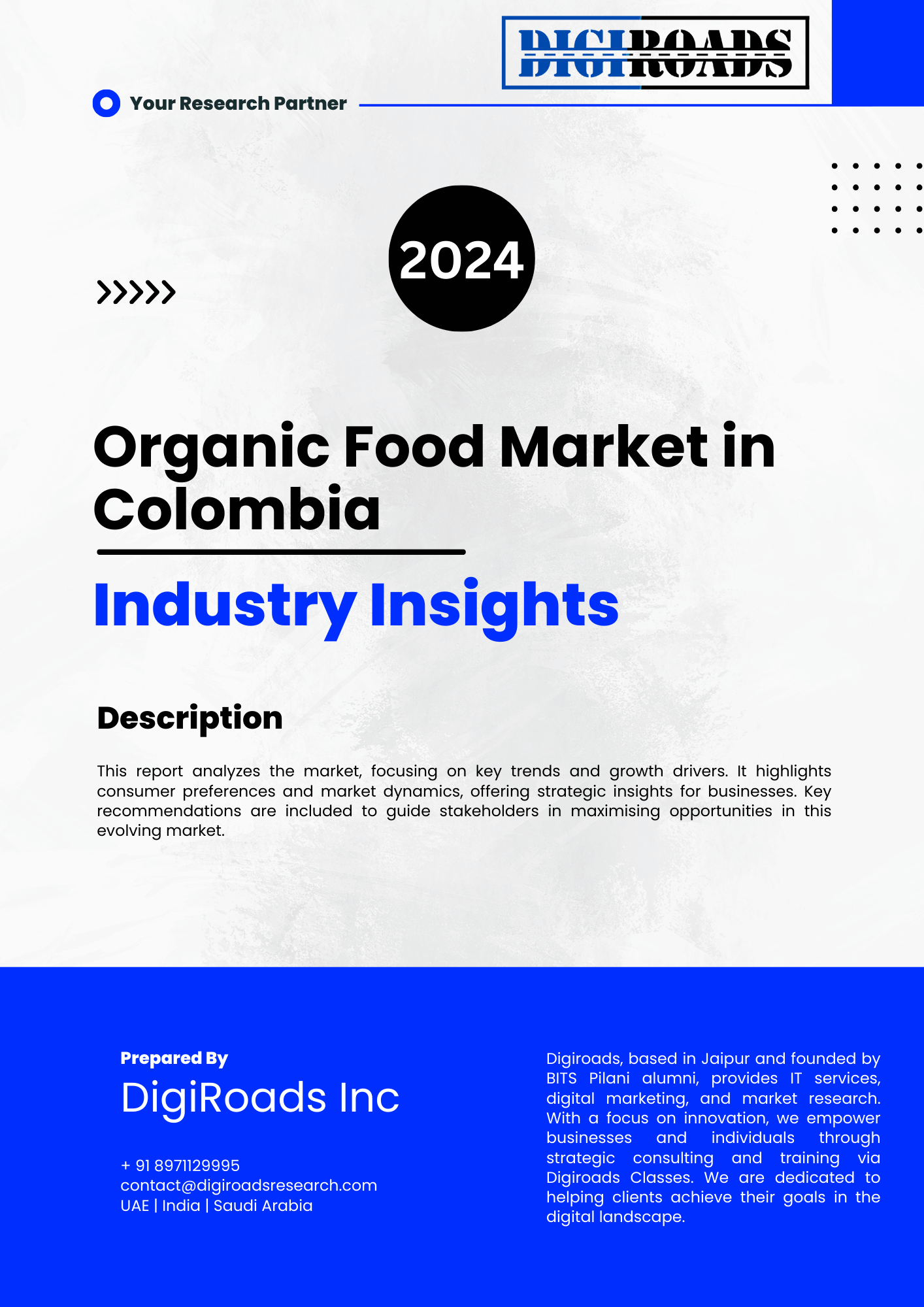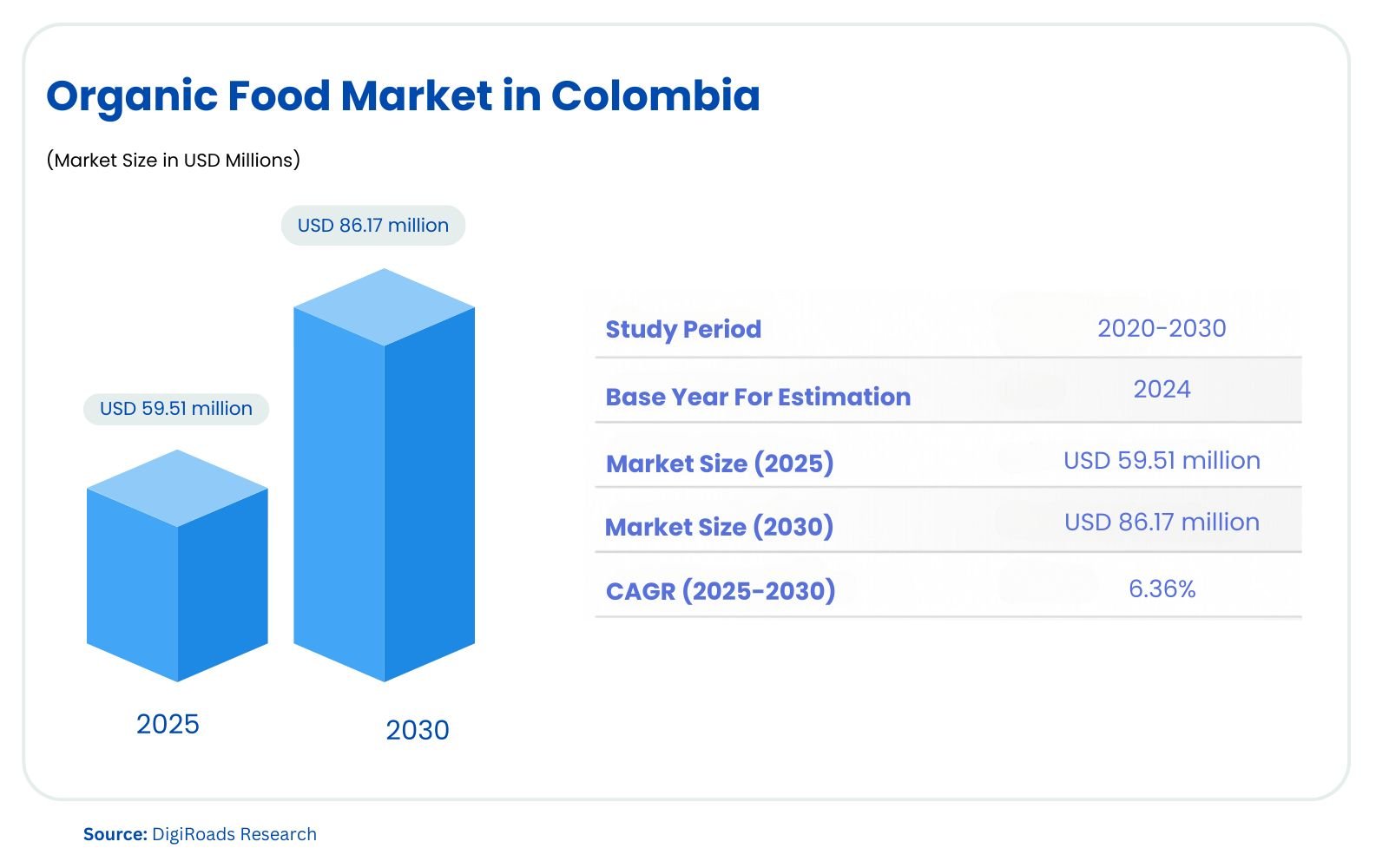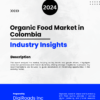No products in the cart.
Organic Food Market in Colombia
- Brand: DigiRoads
Organic Food and Beverage Market Report in Colombia: This 100+ pages report provides detailed insights into market trends, growth drivers, and key players. Available in PDF and Excel formats for comprehensive analysis and easy data access.
Category: Food and Beverage
Brand: DigiRoads
Organic Food Market in Colombia Report | Market Size, Industry Analysis, Growth Opportunities, & Forecast (2025-2030)
Organic Food Market in Colombia Overview
The organic food market in Colombia is witnessing steady growth, with an estimated market size of USD 59.51 million in 2025, and is projected to reach USD 86.17 million by 2030, expanding at a CAGR of 6.36% during the forecast period 2025-2030. The organic food market in Colombia is experiencing significant growth, driven by increasing consumer awareness of health and sustainability. As Colombians become more conscious of the benefits of organic products, demand for organic fruits, vegetables, dairy, meat, and beverages continues to rise. With a growing middle class and greater access to information, consumers are increasingly opting for food items that are free from pesticides and chemicals. The market is supported by both local production and imports, as Colombian farmers embrace organic farming practices to meet the evolving consumer demand.
Supermarkets, specialty stores, and online platforms are the main distribution channels for organic products in Colombia, making them more accessible to a broader consumer base. The Colombian government also plays a role in encouraging organic agriculture through supportive policies and certification programs. As environmental concerns rise, consumers are seeking more sustainable and eco-friendly food options. The market is set to expand further in the coming years, with both domestic and international brands targeting Colombian consumers. This report provides an in-depth analysis of market trends, growth drivers, and opportunities in Colombia’s organic food sector.
Market Report Coverage:
The “Organic Food Market in Colombia Report—Future (2025-2030)” by Digiroads Research & Consulting covers an in-depth analysis of the following segments in the market.
| Organic Fruits & Vegetables | Chemical-free fruits and vegetables. |
| Organic Meat, Fish & Poultry | Hormone- and antibiotic-free meat, fish, and poultry. |
| Organic Dairy Products | Dairy products without additives. |
| Organic Beverages | Organic juices, coffee, tea, and non-dairy drinks. |
| Organic Frozen & Processed Foods | Frozen meals and processed foods without preservatives. |
Study Assumptions and Definitions
This study on the Organic Food Market in Colombia assumes that the demand for organic food will continue to grow due to increasing consumer awareness of health and environmental benefits. The market’s growth is projected based on historical trends, consumer behavior, and governmental policies encouraging organic farming. The study assumes steady economic growth in Colombia, which will lead to rising disposable incomes, allowing more consumers to afford organic products. It also considers the growing trend of e-commerce and online food distribution, which is expected to further drive market expansion.
For the purpose of this study, organic food is defined as products grown and processed without the use of synthetic chemicals, including pesticides, fertilizers, and preservatives. Organic farming practices emphasize environmental sustainability and soil health, and products are certified by recognized organic certification bodies. The term organic beverages includes drinks such as organic juices, teas, coffee, and non-dairy alternatives. Distribution channels include supermarkets, hypermarkets, specialty stores, and online platforms, which are the primary means of reaching consumers. The geographical scope of this study covers Colombia, and it is analyzed in the context of both local production and imports of organic food products.
Market Scope
The scope of the Organic Food Market in Colombia encompasses a comprehensive analysis of organic food products and beverages available in the country. This includes organic fruits and vegetables, meats, poultry, dairy products, frozen foods, and a range of organic beverages such as juices, coffee, tea, and non-dairy alternatives. The study focuses on the key distribution channels driving growth, including supermarkets, hypermarkets, specialty stores, and online platforms, all of which play a crucial role in reaching Colombian consumers.
Geographically, the scope is limited to Colombia, highlighting both domestic production and imports of organic products. The market analysis examines current trends, consumer behavior, regulatory frameworks, and the competitive landscape, providing insights into key players and market dynamics. Furthermore, the study considers factors such as economic growth, rising health awareness, and the increasing adoption of sustainable practices, all of which influence the demand for organic food in Colombia. The forecast period covers the years 2025 to 2030.
MARKET OUTLOOK
Executive Summary
The Organic Food Market in Colombia is experiencing significant growth, driven by increasing consumer awareness of health benefits and environmental sustainability. As more people seek healthier food options, demand for organic food products, including fruits, vegetables, dairy, meat, and beverages, continues to rise. Organic foods are perceived as safer and more nutritious, contributing to their growing popularity among Colombian consumers. The market is further supported by government initiatives promoting organic farming practices, ensuring the safety and quality of organic products.
The market is segmented by product type, distribution channel, and geography. Key product categories include organic fruits and vegetables, dairy products, meats, poultry, and a variety of organic beverages like juices, coffee, and tea. Distribution channels are diverse, with supermarkets, hypermarkets, specialty stores, and increasingly popular online platforms serving as key sales avenues. The growing e-commerce sector is particularly contributing to the expansion of the market, allowing consumers to access organic products more easily.
Colombia, with its large agricultural sector, presents a significant opportunity for organic food production. Domestic production is growing, but the country also imports organic products to meet the rising demand. The competitive landscape is dynamic, with international and local players investing in product innovation and market expansion.
As consumer preferences shift towards organic and sustainable food choices, the market is expected to continue its upward trajectory. Rising disposable incomes, increased awareness of the environmental impact of conventional farming, and a focus on healthier lifestyles are all expected to fuel growth.
COMPETITIVE LANDSCAPE
The Organic Food Market in Colombia is moderately fragmented, with regional and multinational players competing fiercely for market share.
Key Market Players
- ConAgra Brands
- Amy’s Kitchen, Inc.
- General Mills, Inc.
- The Hain Celestial Group
- Danone Food Company
- United Natural Foods, Inc. (UNFI)
- Organic Valley
- Belvoir Fruit Farms Ltd.
- Dean Food Company
- Grain Forests
Market Share Analysis
The market share analysis of the Organic Food Market in Colombia highlights the competitive landscape and the distribution of market dominance among key players. Major international and local companies, including ConAgra Brands, Amy’s Kitchen, General Mills, Danone, and The Hain Celestial Group, collectively hold a significant share of the market, driven by product innovation, strong brand recognition, and extensive distribution networks. These companies have successfully capitalized on the growing consumer demand for organic products by offering a diverse range of organic foods and beverages.
In Colombia, the supermarkets and hypermarkets dominate the retail segment, accounting for the largest portion of sales. This is followed by specialty stores and online platforms, which are rapidly gaining traction due to increasing e-commerce adoption among health-conscious consumers.
Local players and smaller brands are gradually gaining ground by tapping into Colombia’s rich agricultural resources, promoting locally grown organic products, and catering to the rising demand for organic offerings. The market is witnessing an influx of private-label organic brands, which are capturing an increasing share due to their cost-effective pricing strategies while maintaining organic quality standards.
MARKET DYNAMICS
Market Drivers and Key Innovations
The Organic Food Market in Colombia is driven by several key factors:
- Health Consciousness: Increasing awareness about the health benefits of organic foods, including their reduced exposure to harmful chemicals and preservatives, is one of the primary drivers. Consumers are becoming more focused on maintaining healthy lifestyles, leading to a rise in demand for organic products.
- Environmental Sustainability: As environmental concerns grow, more consumers are opting for organic food to support sustainable agricultural practices. Organic farming helps preserve soil quality, reduce pollution, and conserve biodiversity, aligning with the growing trend toward eco-friendly choices.
- Government Support: The Colombian government has implemented initiatives to promote organic farming, such as subsidies for organic producers and certification programs. This creates a favorable environment for the growth of organic agriculture.
- Rising Disposable Income: With growing middle-class income, more Colombians have the financial capability to invest in organic foods, which are often perceived as premium products.
Key Innovations
- Product Diversification: Companies are continually introducing innovative organic food products to meet consumer needs. This includes the development of new organic beverages, plant-based alternatives, and organic snacks to cater to diverse dietary preferences.
- E-commerce Growth: The rise of online shopping platforms has expanded access to organic products. Many brands have adopted digital channels, offering consumers greater convenience and choice in purchasing organic items.
- Packaging Innovations: To further appeal to environmentally conscious consumers, companies are innovating with eco-friendly and biodegradable packaging for organic products, reducing their carbon footprint and enhancing their market appeal.
Market Challenges
- High Cost of Production: Organic farming generally involves higher production costs due to the lack of synthetic fertilizers and pesticides, making organic food products more expensive than conventional ones. This price difference can be a barrier for price-sensitive consumers.
- Limited Supply Chain Infrastructure: The supply chain for organic food in Colombia faces challenges related to logistics, storage, and transportation, which can impact the availability and freshness of organic products in remote areas.
- Regulatory Challenges: The lack of standardized regulations and certifications for organic food in some regions creates confusion and hinders consumer confidence in the authenticity of organic products.
- Lack of Consumer Awareness: Despite growing interest in organic foods, there is still a significant portion of the population in Colombia that is unaware of the benefits and availability of organic products, limiting market growth.
- Small Market Size: While the organic food market is growing, it remains relatively small compared to conventional food markets. This limits the purchasing power and competitive pressure to drive innovation in the sector.
- Competition from Conventional Products: Conventional food products are often more readily available and less expensive, making it difficult for organic foods to gain widespread acceptance, particularly among lower-income consumers.
- Limited Local Organic Farming: While there is potential, the local production of organic foods is still limited in Colombia, requiring significant imports to meet market demand, which adds to costs and supply chain complexity.
Market Opportunities
- Growing Health Consciousness: Increasing awareness of the health benefits associated with organic food provides a significant opportunity for market growth. As more Colombians embrace healthier lifestyles, demand for organic products is expected to rise.
- Expanding Middle Class: The growing middle class in Colombia is increasing disposable income, which creates an opportunity for organic food producers to target higher-income consumers who are willing to pay a premium for organic products.
- Government Support and Incentives: Government initiatives to support organic farming through subsidies, certifications, and training programs present an opportunity for both local and international companies to enter the market with more affordable, certified organic products.
- E-commerce Growth: The rise of online shopping platforms in Colombia presents a significant opportunity for organic food companies to reach a broader audience, especially in rural and underserved areas where physical retail outlets may be scarce.
- Rising Demand for Plant-Based Foods: As the plant-based food trend grows globally, there is an opportunity to introduce more organic plant-based alternatives, such as organic plant-based milk, meat substitutes, and snacks, catering to health-conscious and vegan consumers.
- Sustainable Packaging Innovations: There is increasing demand for eco-friendly packaging solutions. Organic food producers who adopt sustainable and biodegradable packaging can gain a competitive edge in the market.
RECENT STRATEGIES & DEVELOPMENTS IN THE MARKET
Increased Investment in Organic Farming
- Data Point: The Colombian government has been supporting organic agriculture through initiatives, offering financial support to farmers transitioning to organic practices.
- Strategy: Encouraging local farmers to adopt organic farming practices and improve certification to meet international standards.
Expansion of Organic Food Retail Networks
- Data Point: The rise of supermarkets and hypermarkets in Colombia, such as Carulla and Exito, increasing their organic product offerings.
- Strategy: Large retail chains are expanding their organic food sections, making these products more accessible to the middle and upper classes in urban areas.
Partnerships with International Organic Brands
- Data Point: Colombian organic food producers are collaborating with international brands like Danone to increase product distribution and penetration in global markets.
- Strategy: These collaborations enable local brands to tap into international markets, increasing export potential.
Launch of E-commerce Platforms for Organic Food
- Data Point: Colombian ecommerce platforms, such as Mercado Libre and Rappi, are seeing an increase in organic food offerings due to the growing trend of online shopping.
- Strategy: Companies are focusing on developing dedicated online platforms or leveraging existing e-commerce platforms to reach consumers across Colombia, especially in rural areas.
Adoption of Sustainable Packaging Solutions
- Data Point: Companies like Alimentos Sacha and Organic Colombia have started adopting sustainable and biodegradable packaging for organic products to align with consumer preference for eco-friendly practices.
- Strategy: Incorporating environmentally-friendly packaging to appeal to environmentally conscious consumers and strengthen brand loyalty.
KEY BENEFITS FOR STAKEHOLDERS
Farmers and Producers
- Access to Premium Pricing: Organic products often command higher prices in the market, offering farmers and producers a higher revenue potential.
- Government Support: Various subsidies, financial support, and initiatives enable farmers to transition to organic farming with reduced financial risks.
- Sustainability and Soil Health: Organic farming practices promote soil health and environmental sustainability, ensuring long-term productivity.
Retailers and Distributors
- Increased Consumer Demand: Growing consumer awareness of health and sustainability has led to an increased demand for organic products, providing an opportunity for retailers to tap into this profitable segment.
- Expansion of Market Reach: Organic products are attracting both local and international consumers, giving distributors the chance to expand their product offerings and reach a broader audience.
- Improved Brand Image: Retailers and distributors offering organic products can enhance their brand image by aligning with the growing trend of eco-consciousness and health awareness.
Consumers
- Health and Nutritional Benefits: Organic foods are free from harmful chemicals, pesticides, and GMOs, offering consumers healthier and more nutritious food options.
- Environmental Impact: By supporting organic products, consumers contribute to environmentally sustainable farming practices that reduce the overall ecological footprint.
- Variety and Quality: With the increasing availability of organic products in diverse categories, consumers benefit from a wider variety of high-quality food and beverage options.
Government and Regulatory Bodies
- Sustainability Goals: Supporting organic agriculture helps meet national sustainability and environmental goals by reducing chemical usage and promoting sustainable farming practices.
- Boost to Local Economies: Encouraging organic farming supports local economies by creating jobs, increasing exports, and driving investment in rural areas.
- Improved Food Safety Standards: Strengthening the certification and regulation of organic food ensures consumer safety, reinforcing public trust in the food supply.
Investors and Market Analysts
- Attractive Investment Opportunities: As the demand for organic food continues to rise, investors can tap into a growing market with the potential for high returns.
- Market Expansion: With the Colombian market opening up, there are new opportunities for foreign and domestic investors to expand into the organic sector, whether in production, distribution, or retail.
- Long-Term Growth Potential: The ongoing trends toward health-conscious eating and environmental sustainability make the organic food market a promising area for long-term growth and investment.
At DigiRoads Research, we emphasize reliability by employing robust market estimation and data validation methodologies. Our insights are further enhanced by our proprietary data forecasting model, which projects market growth trends up to 2030. This forward-thinking approach ensures our analysis not only captures the current market landscape but also anticipates future developments, equipping stakeholders with actionable foresight.
We go a step further by offering an exhaustive set of regional and country-level data points, supplemented by over 60 detailed charts at no additional cost. This commitment to transparency and accessibility allows stakeholders to gain a deep understanding of the industry’s structural and operational dynamics. By providing exclusive and hard-to-access data, DigiRoads Research empowers businesses to make informed strategic decisions with confidence.
In essence, our methodology and data delivery foster a collaborative and data-driven decision-making environment, enabling businesses to navigate industry challenges and capitalize on opportunities effectively.
Contact Us For More Inquiry.
Table of Contents
INTRODUCTION
- Market Overview
- Years Considered for Study
- Market Segmentation
- Study Assumptions and Definitions
- Market Scope
RESEARCH METHODOLOGY
MARKET OUTLOOK
- Executive Summary
- Market Snapshot
- Market Segments
- By Product Type:
- Organic Meat, Fish & Poultry, Organic Dairy Products, Organic Beverages, Organic Frozen & Processed Foods
- By Distribution Channel:
- Supermarkets/Hypermarkets, Specialty Stores, Online Stores
- By Geography:
- South America
- By Product Type:
COMPETITIVE LANDSCAPE
- Recent Strategies (Key Strategic Moves)
- Market Share Analysis
- Company Profiles
- ConAgra Brands
- Amy’s Kitchen, Inc.
- General Mills, Inc.
- The Hain Celestial Group
- Danone Food Company
- United Natural Foods, Inc. (UNFI)
- Organic Valley
- Belvoir Fruit Farms Ltd.
- Dean Food Company
- Grain Forests
MARKET DYNAMICS
- Market Drivers
- Market Challenges
- Market Opportunities
- Porter’s Five Forces’ Analysis
- Bargaining Power of Suppliers
- Bargaining Power of Buyers
- Threat of New Entrant
- Threat of Substitutes
- Competitive Rivalry
GLOSSARY OF PROMINENT SECONDARY SOURCES
DISCLAIMER
ABOUT US



